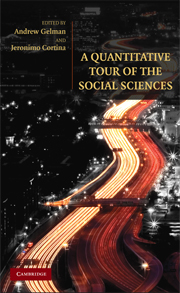Book contents
- Frontmatter
- Contents
- Preface: Learning to Think Like a Social Scientist
- About the Contributors
- PART I MODELS AND METHODS IN THE SOCIAL SCIENCES
- PART II HISTORY
- PART III ECONOMICS
- PART IV SOCIOLOGY
- PART V POLITICAL SCIENCE
- 15 What Is Political Science?
- 16 The Politics of Supreme Court Nominations: The Critical Role of the Media Environment
- 17 Modeling Strategy in Congressional Hearings
- PART VI PSYCHOLOGY
- PART VII TO TREAT OR NOT TO TREAT: CAUSAL INFERENCE IN THE SOCIAL SCIENCES
- References
- Index
- References
17 - Modeling Strategy in Congressional Hearings
The Critical Role of the Media Environment
Published online by Cambridge University Press: 05 June 2012
- Frontmatter
- Contents
- Preface: Learning to Think Like a Social Scientist
- About the Contributors
- PART I MODELS AND METHODS IN THE SOCIAL SCIENCES
- PART II HISTORY
- PART III ECONOMICS
- PART IV SOCIOLOGY
- PART V POLITICAL SCIENCE
- 15 What Is Political Science?
- 16 The Politics of Supreme Court Nominations: The Critical Role of the Media Environment
- 17 Modeling Strategy in Congressional Hearings
- PART VI PSYCHOLOGY
- PART VII TO TREAT OR NOT TO TREAT: CAUSAL INFERENCE IN THE SOCIAL SCIENCES
- References
- Index
- References
Summary
In the previous chapter, we concluded that manipulating the media environment is a central concern for strategic players in the “game” of Supreme Court nominations. From this perspective, the president and his allies must try to establish a favorable media environment for the nominee. Individuals opposed to the nominee and the president must do the reverse: establish a hostile environment. Of course, a favorable environment may include flying under the radar – no attention in the media, or very little.
How can strategic actors manipulate the information environment? A useful distinction is between direct and indirect manipulation. By “direct manipulation,” I mean, for example, the president going public (making speeches) on behalf of the nominee, interest groups staging protests and demonstrations, and members of the Judiciary Committee shaking their finger at the nominee and asking “gotcha” questions about judicial doctrine. These are direct manipulations because the media may deem them newsworthy and broadcast them or report on them.
Indirect manipulation is somewhat more subtle. The idea is that you engage in actions that make direct manipulations (your own or others) more or less effective, or encourage reporters to write the right kinds of stories on their own. Consider, for example, the president's choice of a moderate versus an extreme nominee or a highly qualified one versus a marginally qualified one. These choices are indirect manipulations of the media because they affect how the media portray the nominee.
- Type
- Chapter
- Information
- A Quantitative Tour of the Social Sciences , pp. 242 - 268Publisher: Cambridge University PressPrint publication year: 2009

